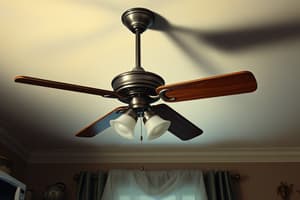Podcast
Questions and Answers
What is the primary goal of lighting psychology?
What is the primary goal of lighting psychology?
Lighting psychology focuses on understanding how lighting influences emotions and behavior.
Which of the following is NOT a key aspect of lighting psychology's influence on human behavior?
Which of the following is NOT a key aspect of lighting psychology's influence on human behavior?
- Financial decisions (correct)
- Cognitive processes
- Physical health
- Social interactions
Warm white light (2700-3000K) is generally associated with feelings of relaxation and comfort.
Warm white light (2700-3000K) is generally associated with feelings of relaxation and comfort.
True (A)
The use of ______ lighting in an office setting is generally associated with improved focus and alertness.
The use of ______ lighting in an office setting is generally associated with improved focus and alertness.
Describe the emotional and behavioral impact of soft lighting in a healthcare setting, as described in the case studies.
Describe the emotional and behavioral impact of soft lighting in a healthcare setting, as described in the case studies.
Explain how lighting can be used to enhance product appeal in retail stores, according to the case studies.
Explain how lighting can be used to enhance product appeal in retail stores, according to the case studies.
What is the primary purpose of the assignment described in the document?
What is the primary purpose of the assignment described in the document?
According to the assignment instructions, what are the three key factors that should be addressed for each real-world example of lighting?
According to the assignment instructions, what are the three key factors that should be addressed for each real-world example of lighting?
Flashcards
Lighting Psychology
Lighting Psychology
The study of how lighting affects emotions, behavior, and well-being in interior spaces.
Warm Light
Warm Light
Yellowish light associated with relaxation and comfort.
Cool Light
Cool Light
Bluish light associated with alertness and focus.
Light and Mood
Light and Mood
Signup and view all the flashcards
Light and Circadian Rhythm
Light and Circadian Rhythm
Signup and view all the flashcards
Light and Productivity
Light and Productivity
Signup and view all the flashcards
Visual Clarity
Visual Clarity
Signup and view all the flashcards
Enhanced Mood
Enhanced Mood
Signup and view all the flashcards
Increased Productivity
Increased Productivity
Signup and view all the flashcards
Creates Ambiance
Creates Ambiance
Signup and view all the flashcards
Safety and Security
Safety and Security
Signup and view all the flashcards
Melatonin
Melatonin
Signup and view all the flashcards
Morning Light
Morning Light
Signup and view all the flashcards
Circadian Rhythms
Circadian Rhythms
Signup and view all the flashcards
Emotional Response to Lighting
Emotional Response to Lighting
Signup and view all the flashcards
Stimulation (Lighting)
Stimulation (Lighting)
Signup and view all the flashcards
Relaxation (Lighting)
Relaxation (Lighting)
Signup and view all the flashcards
Excitement (Lighting)
Excitement (Lighting)
Signup and view all the flashcards
Study Notes
INTA 419: Sense of Space
- Course title: INTA 419, Sense of the Space
- Presenter: Dr. Basma Gbr
- College/Centre: College of Engineering, Interior Architectural Engineering
- Semester: Fall 2024/2025
Design Process: Thinking with Diagrams in Interior Design
- Lighting Psychology: Lighting influences emotions, behavior, and well-being.
- Importance of Lighting:
- Visual Clarity
- Enhances mood and well-being
- Affects productivity
- Creates ambiance and atmosphere
- Safety and security (reduces accidents, increases visibility).
The Science of Light and Its Impact on Human Behavior
- Light and Mood: Color temperature affects emotions (warm light = relaxation, cool light = alertness).
- Light and Circadian Rhythm: Natural light regulates sleep-wake cycle.
- Light and Productivity: Bright light boosts productivity, while dimmer light promotes creativity and relaxation.
Emotional Responses to Lighting
- Stimulation: Bright, white light increases alertness and energy.
- Relaxation: Warm, yellow light creates calm, comfort, and relaxation.
- Excitement: Red light can increase heart rate and blood pressure, potentially leading to excitement or aggression.
Circadian Rhythms and the Importance of Natural Lighting
- Morning: Sunlight suppresses melatonin, promoting wakefulness.
- Afternoon: Continued daylight maintains alertness.
- Evening: Minimizing bright light promotes melatonin production for sleep.
Lighting for Productivity, Relaxation, and Wellness
- Productivity: Bright, focused light sources improve visibility and reduce eye strain.
- Relaxation: Soft, warm lighting promotes relaxation and sleep.
- Wellness: Natural light regulates circadian rhythm and promotes overall well-being.
Psychological Effects of Different Color Temperatures
- Warm White (2700-3000K): Relaxing, cozy, inviting.
- Neutral White (3000-4000K): Alerting, focused, energizing.
- Cool White (4000-6500K): Stimulating, activating, stylish.
Lighting Design Principles for Mood and Atmosphere
- Color Temperature: Warm white light creates cozy, relaxing ambiance.
- Light Intensity: Varying light levels create different moods (brighter for focus, dimmer for relaxation).
- Light Direction: Direct lighting highlights areas, while indirect creates a softer ambiance.
Adaptive Lighting: Customizing Illumination for Different Spaces
- Office: Task lighting, natural light (focus, alertness).
- Bedroom: Dimmable warm lights (relaxation, sleep).
- Restaurant: Dim, warm lighting (familiarity, emotional).
Case Studies: Lighting's Impact in Different Settings
- Healthcare: Soft lighting reduces stress and promotes healing.
- Workplaces: Proper lighting boosts productivity and reduces eye strain.
- Retail Stores: Warm lighting attracts customers and enhances product appeal.
- Restaurants: Dim lighting creates a romantic ambiance and encourages lingering.
Assignment 4: Identifying and Describing Real-World Lighting Examples
- Students need to identify five real-world examples of interior spaces, describe their lighting principles and their emotional impact.
- Consider details like: space type, lighting principles (ambient, task, accent, color, intensity; natural vs. artificial), and emotional/behavioral impact on individuals. (e.g., mood, productivity, comfort, social interaction, relaxation, and creativity).
Studying That Suits You
Use AI to generate personalized quizzes and flashcards to suit your learning preferences.




